Societas Heraldica Slovenica
October 2005
Podružnična cerkev Marijinega oznanenja v Crngrobu
The following paragraphs (between the two horizontal lines) were transcribed directly, with minor grammatical corrections, from the plaque attached to the wall next to the main doors of the church. This text offers a good background on the history and structure of the church. Details on the heraldic nature of the church follow after these paragraphs. All images in this article are courtesy of the writer, David M. Cvet (October 2005). Click on any image to view an enlarged image of the same.
The church is amongst the most important historical monuments in Slovenia for its architecture as well as for its frescoes, stone details and interior 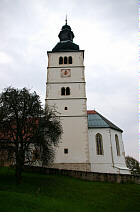 | 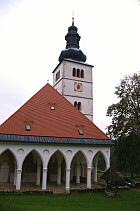 | | north orientation | south orientation |
artifacts. Early in the 13th century, there was an existing small pilgrimage church in the area of the present north nave of Crngrob. It eventually became too small to host the more and more pilgrims arriving. In the 1350 another nave was built and the church remained the same for over one hundred years. Around 1453 the third nave was built, which is visible due to the vertical crack on the west facade. The first and the second churches each had flat ceilings. Nevertheless, after the third nave was constructed, all three naves were renovated to become vaulted ceilings, thus the remains of the original beams can only be seen in two first naves. In the years 1521 - 1524, construction began to build the present hall presbytery and the belfry in the area of the three apses (Master Jurko from Loka). The belfry was later rebuilt twice and it finally achieved its present form in 1665. In 1858 a neo-Gothic portico was added in front of the west facade resulting in the various styles of architecture in the same church, i.e. Roman, Gothic, baroque and deo-Gothic styles.
The church is noted for the famous guilded alter which is the largest of its kind in Gorenjsko. It was constructed in 1652 and is decorated with almost one hundred statuettes depicting angels.  | the vaulted ceiling - notice the arms of
Carniola in the centre |
Hanging on the sidewalls are numerous paintings brought to the Church by pilgrims as a form of gratitude for granted requests. The ceiling of the presbytery is vaulted and it also is rich with frescoe paintings.
The rib of "the giant girl" is a particularly unique artifact in this church. The legend says she was so large that when she stood, one leg was standing on Šmarma gora (near Ljubljana) and the second leg on Šmarjetna gora (near Kranj) to enable her to gather stones from the river Sava in order to help build the church. Her rib now hangs from a timber beam which shows that the first ceiling was flat and made of wood. The beams were sawn around 1450 therefore we can approximate that the rib has been suspended there for 550 years.
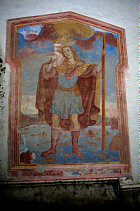 | 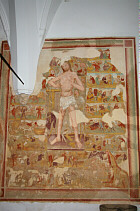 | south wall depicting the
patron saint St. Christopher | south wall depicting Jesus
Christ and life of the time |
In the north nave under the rib, there is a very rich guilded altar of St. Martin from 1680. Next to the pillars of the middle nave are two more small altars from the second half of the 17th century. The one on the right is dedicated to St. Agatha and the one on the left to St. Lucia. in the south nave is the altar of St. Ahaz. According to the findings of a restorer, the Baroque organ is dated from 1743. It is on the south side of the presbytery and it was made by master Janačeck from Celje. Its artistic value is very high for the quality of the material as well as for its composition. The church also displays an exceptional collection of the Stations of the Cross originally created by Layer. Old inscriptions in Adam Bohorič alphabet are 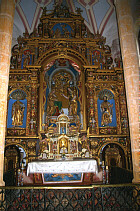 | Guilded alter depicting nearly
100 statuettes of angels. |
preserved on their frames. The belfry is 62 m high requiring more than a hundred stairs to get to the top, and which contains four bells. The largest bell is dated from 1808 and it displays the oldest Slovene incription on a bell.
The outside walls of the church also presents richly colored frescoes. The south wall of the belfry is the home of the fresco of St. Christopher originally painted in 1863. He is the patron of boatmen, raftsmen and drivers. On the south side of the church nave are remains of "the old Christopher" from 1464. The outside west wall under the portico has on its oldest left side, the Passion dated around 1400 by a Friulian artist. On the right side there is the scene of Holy Sunday produced in the workshop of John of Ljubljana around 1460. The main fresco of Jesus Christ is surrounded by scenes clearly depicting the life of people in that time. They depict activities that must not be done on Sundays.
Crngrob - Place of Pilgramage
The largest pilgrimage gathering used to be on White Monday with up to 30 processions arriving from various local towns. Today, only organized groups from some nearby parishes visit the church regularly each year. Masses are celebrated on all Mary's feasts. Most people come to Crngrob on Sundays in May for May devotions at 4 pm. Pilgrimage groups from across Slovenia and individuals from across the world also come to visit Crngrob, which is evident in the guest book signed by visitors.
From the plaque, Crngrob
Coats of Arms at Crngrob...
The images below depict some of the coats of arms visible at Crngrob. The arms can be seen on the ceiling, the alters and on the elaborate wood carvings forming the pulpit and alters. According to the guide, a gentleman that volunteers his time to open the church to enable visitors entry, indicated that the personal arms are those noble families who have contributed in some significant way to the church. Based on this information, the personal arms of von Lampfrizham, a baron of Raumbschissel were identified as such in Valvasor's Opus Insignium Armorumque on page 108 lower right in the armory, as depicted lower right below the images below. Unfortunately, the other personal arms were not identified in the armory. The noble coats of arms in Crngrob were created in a shape in what is known in heraldry as a "lozenge" shape.
 |
 |
 |
| von Lampfrizham* |
unknown arms |
arms of Carniola |
| |
 |
 |
 |
| ecclesiastical arms |
unknown arms |
arms on the pulpit |
* v.Lampfrizham pp 108, 109 - (Carniolian section in Opus Insignium Armorumque).
 | v. Lampfrizham's entry
in Valvasor's armory |
The coat of arms of Carniola reside at the apex of the vaulted ceiling as does the unidentified ecclesiastical arms, however, the Carnolian arms, the eagle is not illustrated ensigned with a crown as is the arms in Valvasor's armory. To view Valvasor's version of the Carniola arms, click here. The unidentified gold arms charged with a silver croissant shaped object, do not have a match in Valvasor's armory. The unknown arms are displayed on the church's pulpit, along with two other un-identified arms visible in the lower right image.
It is clear that heraldry played an important role in Slovenian history by virtue of numerous instances of the representation of individuals or families through the creation of a facsimile of coats of arms in architecture, even in a relatively little known church north of Ljubljana. It is also important to note that further heraldic research is necessary to identify the many other coats of arms found throughout Slovenia in other architectural monuments in order to more fully appreciate their heraldic history and the contributions made by the families, noble or otherwise to the evolution of Slovenia. If in the future, the other unidentified arms depicted above become known, those updates will be reflected in this article.
Bibliography
by David M. Cvet
Societas Heraldica Slovenica
October 2005
Avtor: , je bil rojen v Kanadi slovenskim staršem. Je direktor Kanadska kraljevska heraldična družba (RHSC) in predsednik podružnice za Toronto, predsednik in ustanovitelj Akademija evropske srednjeveške borilne veščine v Torontu. Je tudi ustanovitelj Societas Heraldica Slovenica. V začetku se je predvsem posvečal srednjeveškim borilnim veščinam in pri tem spoznal kako pomembno zgodovinsko vlogo je imela heraldika. Svoje raziskave in študij je razširil na Slovenijo.
SHS Copyright © 2005 All Rights Reserved
Updated: October 29, 2005
|












